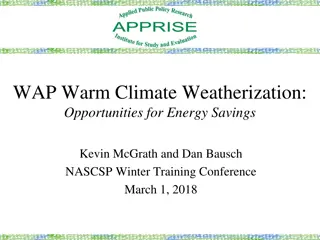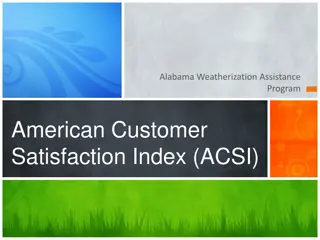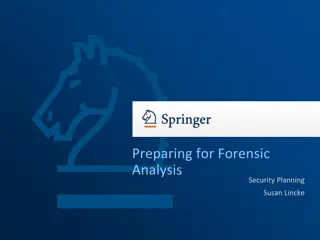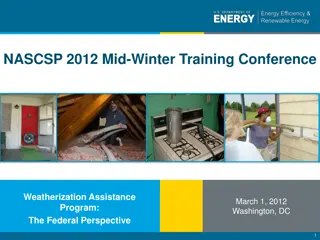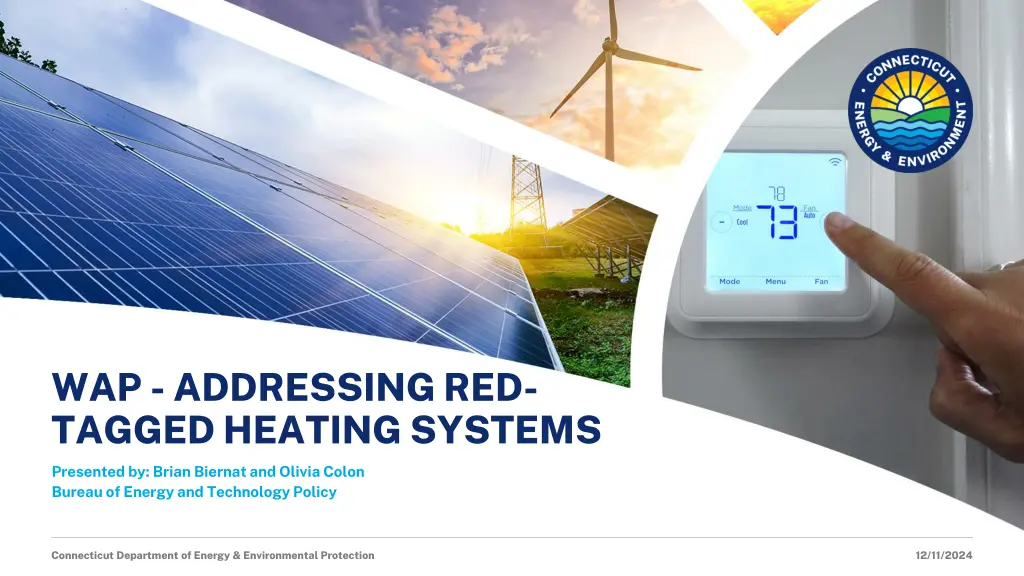
Addressing Red-Tagged Heating Systems with WAP Assistance
Learn how the Weatherization Assistance Program (WAP) can address red-tagged heating systems for low-income households, including eligibility criteria, funding sources, and available resources. Explore the considerations for repair or replacement within the program's guidelines to improve energy efficiency and reduce energy costs. Discover the potential modifications to enhance support for non-operational heating systems through the program's operations and Health & Safety budget.
Download Presentation

Please find below an Image/Link to download the presentation.
The content on the website is provided AS IS for your information and personal use only. It may not be sold, licensed, or shared on other websites without obtaining consent from the author. If you encounter any issues during the download, it is possible that the publisher has removed the file from their server.
You are allowed to download the files provided on this website for personal or commercial use, subject to the condition that they are used lawfully. All files are the property of their respective owners.
The content on the website is provided AS IS for your information and personal use only. It may not be sold, licensed, or shared on other websites without obtaining consent from the author.
E N D
Presentation Transcript
WAP - ADDRESSING RED- TAGGED HEATING SYSTEMS Presented by: Brian Biernat and Olivia Colon Bureau of Energy and Technology Policy Connecticut Department of Energy & Environmental Protection 12/11/2024
WHAT IS WAP? Weatherization Assistance Program (WAP) The US Department of Energy (DOE) funds the Weatherization Assistance Program This program assists low-income persons in minimizing energy-related costs and fuel usage in their homes through retrofits and home improvement measures The Single-family program serves 1-4 unit buildings Formula funding (~$3 Million per year) Goal of serving ~200 homes per year Multifamily program which serves 5+ unit buildings Funded by the Bipartisan Infrastructure Law (BIL) Goal of serving ~3,500 units by 2027 Connecticut Department of Energy & Environmental Protection 12/11/2024
CAN WAP ADDRESS RED-TAGGED SYSTEMS? Depends on several factors WAP is an energy efficiency program, any upgrades in a home must reduce energy consumption WAP takes a whole home approach to energy efficiency, meaning that the funds cannot be used to only upgrade one aspect of the home WAP can repair or replace red-tagged units if 1. A whole-home energy audit is completed 2. The repair or replacement can fit within a full project scope 3. Repairing or replacing the system will result in a reduction of energy use in the home 4. And the repair or replacement fits within the Health & Safety (H&S) and Average Cost Per Unit (ACPU) guidelines Given the high costs associated with replacing a heating system, this often places these homes outside the scope of WAP and results in a deferral Connecticut Department of Energy & Environmental Protection 12/11/2024
WHAT RESOURCES ARE AVAILABLE WITHIN WAP TO HELP? WAP s Program Operations budget Used for energy conservation measures (ECMs) Can pay for heating systems if a repair/ replacement will lower energy consumption WAP s Health & Safety (H&S) budget Capped at 15% of the Program Operations budget category Subgrantees are expected to balance this budget across the needs of the total number of homes they must serve in a given Program Year (i.e., total H&S budget / goal # of units = average H&S spend per home). This means that the Subgrantee s capacity to replace heating systems may be limited depending on the cost of each project. We are exploring if DOE will permit us to modify our program and increase the H&S budget which could allow us to better serve clients with non-operational heating systems while making their homes more energy efficiency. Connecticut Department of Energy & Environmental Protection 12/11/2024
HOW IS HEATING EQUIPMENT RED-TAGGED WITHIN WAP? WHAT ARE THE CRITERIA AND WHO MAKES THE DETERMINATION? During the initial audit, a WAP auditor will test the heating system to identify any problems If there are any issues, the auditor will explain the issue to the customer Will contact the fuel provider company or a contracted HVAC technician to address the issue Auditor will remain in the unit until the fuel provider or HVAC technician makes determination Ultimately, an experienced technician makes the final decision to red-tag a unit Connecticut Department of Energy & Environmental Protection 12/11/2024
WHAT CURRENTLY HAPPENS IN WAP WHEN A PIECE OF EQUIPMENT IS FOUND TO BE (OR BECOMES CLASSIFIED AS) RED-TAGGED ? Upon entering the unit, auditor will read the red-tag If necessary, the auditor will contact the person that originally red-tagged the unit DOE s guidance states if a system is non-operational and non-repairable The auditor will look at the baseplate/ boilerplate to determine the system s efficiency If the system can be replaced with a more efficient one and have an SIR greater than 1.0, then WAP can use its Program Operations funds to pay since the new system would qualify as an ECM Currently, CT s Program Operations Manual does not have this policy incorporated We are working with a technical consultant to update our documentation with this guidance and seek DOE approval If it is not an efficiency measure, but still fits into the scope of a project, it can be billed as a H&S (which is a limited funding category) WAP service providers must solicit three bids from contractors before a replacement is completed Connecticut Department of Energy & Environmental Protection 12/11/2024
CAN DEEPS RESIDENTIAL ENERGY PREPARATION SERVICES (REPS) PROGRAM HELP AT ALL? HOW DO RED- TAGGED HOMES MOVE THROUGH THE REPS PROGRAM TO RESOLVE THE ISSUE AND COME BACK INTO THE HES- IE OR WAP PROGRAM? Unfortunately, the REPS program is unable to help to serve these units If a non-operation unit is identified and red-tagged during REPS work Client is directed to call 211 for further assistance REPS funding is limited to measures that prevent weatherization Heating system replacement is currently not an approved measure within REPS REPS typically addresses issues that are health and safety barriers to the contractors (e.g., mold, asbestos, etc.) Heating systems fall outside of the REPS purview Connecticut Department of Energy & Environmental Protection 12/11/2024
ARE THERE SOME OPPORTUNITIES WE SHOULD BE AWARE OF AND CONSIDER INCORPORATING IN THE HES, HES-IE AND WAP PROGRAMS? WAP WRF (Weatherization Readiness Funds) This is a WAP funding source that can be used to address barriers to weatherization. Total amount of funding for each unit is capped at $30,000. WRF can be used to cover H&S costs when a unit might otherwise be deferred. This funding is expected to be used on multiple types of barriers to weatherization (i.e., major roof repairs, mold remediation, etc.) and not solely furnace replacements. Currently, we can use WRF to replace a heating system if the need is well documented. However, heating systems are not an official measure in our WRF plan. We are exploring if DOE will allow us to add inoperable heating system replacements to CT s WRF plan. Connecticut Department of Energy & Environmental Protection 12/11/2024














